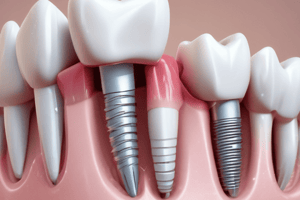Podcast
Questions and Answers
______ is a fixed restoration and appears to the patient to replace only the anatomical crowns of the missing natural teeth. To fabricate this restoration type, there must be minimal loss of hard and soft tissues. The volume and position of the residual bone must permit ideal placement of the implant in a location similar to the root of a natural tooth. The final restoration appears very similar in size and contour to most traditional fixed prostheses used to restore or replace natural crowns of teeth.
______ is a fixed restoration and appears to the patient to replace only the anatomical crowns of the missing natural teeth. To fabricate this restoration type, there must be minimal loss of hard and soft tissues. The volume and position of the residual bone must permit ideal placement of the implant in a location similar to the root of a natural tooth. The final restoration appears very similar in size and contour to most traditional fixed prostheses used to restore or replace natural crowns of teeth.
FP-1
The FP-1 prosthesis is most often desired in the ______, especially in the esthetic zone during smiling or speaking.
The FP-1 prosthesis is most often desired in the ______, especially in the esthetic zone during smiling or speaking.
maxillary anterior region
The restorative material of choice for FP-1 prosthesis is ______.
The restorative material of choice for FP-1 prosthesis is ______.
porcelain to noble-metal alloy
A single tooth FP-1 crown may use ______.
A single tooth FP-1 crown may use ______.
In ______. The first three options are fixed prostheses (FPs). These three options may replace partial (one tooth or several) or total dentitions and may be cemented or screw retained. The last two types of implant restorations are removable prostheses (RPs); they depend on the amount of implant support, not the appearance of the prosthesis.
In ______. The first three options are fixed prostheses (FPs). These three options may replace partial (one tooth or several) or total dentitions and may be cemented or screw retained. The last two types of implant restorations are removable prostheses (RPs); they depend on the amount of implant support, not the appearance of the prosthesis.
Flashcards are hidden until you start studying
Study Notes
FP-1 Prosthesis
- Appears to replace only the anatomical crowns of missing natural teeth
- Requires minimal loss of hard and soft tissues for fabrication
- Ideal for situations where residual bone volume and position permit ideal implant placement
Characteristics of FP-1 Prosthesis
- Final restoration appears similar in size and contour to traditional fixed prostheses
- Often desired in the esthetic zone, especially during smiling or speaking
Prosthetic Materials and Options
- Restorative material of choice: Ceramic
- A single tooth FP-1 crown may use a single implant and abutment
- Multiple teeth can be restored with multiple implants and abutments
Implant Restoration Options
- Fixed prostheses (FPs): replace partial or total dentitions, may be cemented or screw retained
- Removable prostheses (RPs): depend on implant support, not appearance of the prosthesis
Studying That Suits You
Use AI to generate personalized quizzes and flashcards to suit your learning preferences.




